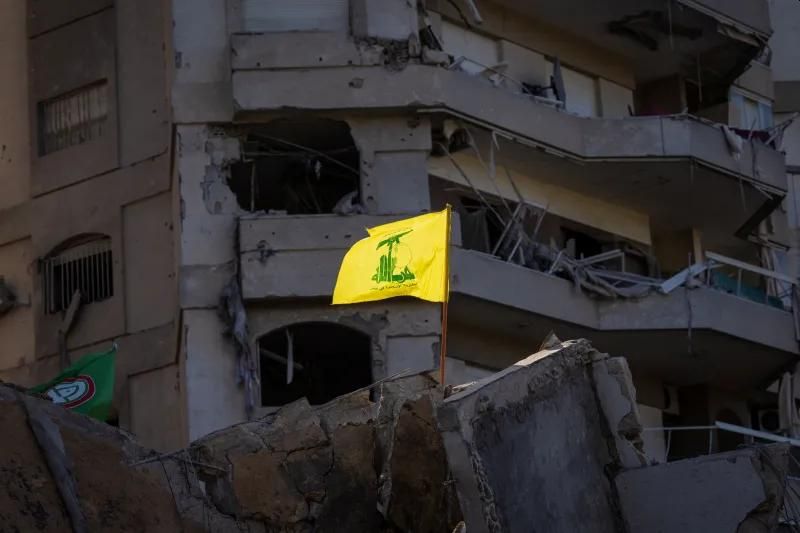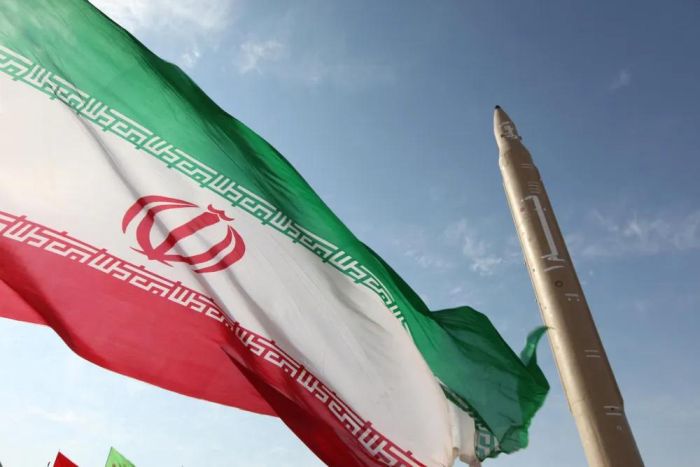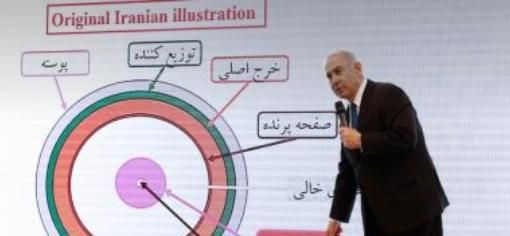By Eric Vandenbroeck and co-workers
Israel’s Latest Wars are Changing Tehran’s
Strategic Calculations
The recent conflicts
in the Middle East have ignited open debate among Iran’s political
elite over whether
the country should weaponize its vast nuclear program. The rationale for doing
so, from Iranian leadership’s perspective, appears more convincing than ever.
Above all, Iran needs
to reestablish deterrence equilibrium with its longtime foes Israel and the
United States. Traditionally, to deter its adversaries from attacking or
implementing regime change, Tehran relied on a three-pronged approach focused
on missiles, militias, and a nuclear program.
To offset its weak
air force, Iran invested heavily in its missiles program, making its arsenal
one of the most advanced in the region. Iran also anchors its asymmetric
warfare strategy through the so-called “forward defense” policy of using
militarized nonstate actors to encircle Israel and the U.S. regional military
presence and to mobilize these forces to attack if required. Iran has
cultivated its relations with groups that are hostile to the United States and
Israel, building the so-called Axis of Resistance, providing them with
arms—including sophisticated missiles and drones—as well as training and
financial support.
However, Iran’s
missiles capabilities and the Axis of Resistance have taken a hit in recent
months. The Israeli onslaught against Iran’s most trusted partner, Hezbollah in
Lebanon, has delivered a blow to its arsenal, fighters, and command and control
structure. Iran was left humiliated by Israel’s ability to assassinate Hamas
leader Ismail Haniyeh while he was in Tehran this summer. Following the killing
of Hamas leader Yahya Sinwar this month, Israel seems determined to keep upping
the ante to establish a new regional order.
Although Hamas and
Hezbollah will continue to undermine Israeli security, the ability of these
groups to mobilize in defense of Iran seems severely diminished while they
fight for their own survival. Meanwhile, the United States has doubled down on
its efforts to shield Israel, moving new anti-missile systems into the country, together with American troops
to operate them, in a bid to defang future attacks from Iran and its allies.
How a Campaign Against Hezbollah Could Lower Iran’s
Inhibitions
Last April, it
appeared as though escalation between Israel and Iran could plunge the entire
Middle East into conflict. Israel’s strikes on the Iranian consulate in
Damascus prompted Iran to retaliate by launching a barrage of missiles and
rockets into Israel—the first time that Iran had openly attacked the country.
But after Israel responded in a relatively muted way, both countries moved on
from the confrontation. Observers, too, put aside their most acute worries,
comforted by the fact that both countries had shown that they had no interest
in a wider war.
This conclusion,
however, was premature. In September, Israel intensified its campaign against
Hezbollah, the Iranian-backed paramilitary group operating in Lebanon. This
marked an important shift: it suggests that Israeli leaders decided they wanted
to actively reshape the balance of power in the Middle East. Much more than its
actions in Gaza, Israel’s war against Hezbollah threatens Iran’s ability to
project power and profoundly diminishes its ability to deter Israeli
interventions into its own domestic politics and nuclear program. The weakening
of Iran’s position will benefit Israelis in the short term. But in the long
term, it will significantly increase the risk of a regional war and even the
likelihood that Iran will acquire nuclear weapons. To avoid being dragged into
yet more conflict in the Middle East, the United States must work to restrain
further Israeli action and stabilize the balance of power.
Phase Shift
Deterrence, at its
core, is the ability of one actor to alter the cost-benefit calculus of another
in order to prevent unwanted actions—usually in an
effort to preserve the status quo. Yet deterrence is rarely synonymous with
absolute peace; rather, it is about preventing an adversary from crossing
specific redlines. During the Cold War, for example, the United States and
Soviet Union were highly effective in deterring each other from launching
preemptive or direct attacks but still conducted decades’ worth of proxy wars,
arms sales to adversaries, and outright invasions of third countries. The
United States has been effective thus far in deterring China from invading
Taiwan but has not prevented China from undertaking other provocative actions
in the South China Sea. The tendency in international politics whereby states
are deterred from direct attacks in favor of indirect action is at the heart of
the stability-instability paradox theorized in security studies—in which stable
nuclear deterrence encourages more aggression using conventional military
methods—and has been a central part of Iranian strategy in the Middle East.
To that end,
deterrence is not only relevant to shaping decisions about whether to act. It
also plays an important role in shaping military strategy once hostilities have
begun. Successful deterrence may then simply be about managing escalation and
preventing specific types of strikes that would damage either country’s
fundamental ability to maintain its security. Which military strategy a country
chooses is almost always—and should be—informed by its adversary’s expected
reaction. U.S. President Joe Biden’s administration, for example, has been
extraordinarily careful to define how Ukrainian forces can use American weapons
in their fight against Russia, because Russia’s threat of nuclear escalation is
at least partly credible. Put another way, the strategy the United States has
pursued to help Ukraine has reflected Russia’s efforts to deter it.
Iranian Basij militia parade

Prior to this
September, the war in the Middle East largely appeared to be contained. For the
most part, Israel’s response to Hamas’s devastating October 7 attack was
confined to the Gaza Strip. Although Israeli leaders have stated since October
7 that they want to eliminate Hamas, that group was less powerful and less
ideologically aligned with Iran than Hezbollah is. Israel’s exchanges with Iran
and Hezbollah mostly conformed to the tit-for-tat deterrence pattern that had
defined its relations with its neighbors for almost two decades.
Even as recently as
April and May, long-standing deterrence norms shaped the strategy that both
Israel and Iran employed. Consider Iran’s response to Israel’s strike on its
Damascus consulate: ahead of its retaliatory missile strike on Israel, Iran’s
leaders went out of their way to ensure that both Israel and the international
community knew that their reprisal was a direct response to the consulate
attack, not the beginning of a larger campaign against Israel nor an indication
of any desire to escalate. The missile strikes themselves—aimed outside of
large population centers and easily intercepted by Israel’s missile defense—did
not suggest that Iran was looking to seriously hurt Israel. Iran’s leaders did
not pursue a more damaging military option because they both sought to deter
and were deterred by Israel: the Iranian strategy
appeared to be driven by the desire to deprive Israeli leaders of a reason to
launch a further escalatory response.
But Israel’s recent
escalation of hostilities into Lebanon in response to progressively more
aggressive incursions by Hezbollah has decisively redefined the deterrence
dynamic that previously kept conflict in the Middle East from escalating. In
the status quo that previously defined the region, Iranian proxy groups’
harassment of Israel enabled Iran to avoid direct confrontation. Hamas and, in particular, Hezbollah functioned as deterrents to
Israeli military action against Iranian interests by keeping Israel distracted.
The threats Hamas and Hezbollah posed to Israel allowed Iran to exert power
across the region while holding Israelis indirectly at risk, which—combined
with Israel’s deterrence in the form of its superior military power—produced a
stable equilibrium.
Over the course of
the past year, however, the fallout from October 7 has changed both Israeli
leaders’ and citizens’ risk calculus. Both have become much less willing to
accept risk from Iranian proxies on Israel’s perimeter and more willing to
accept escalation with Iran. As the military campaign in Gaza turned in
Israel’s favor, returning to the pre-October 7 status quo became less
acceptable to Israeli leaders. U.S. assistance in the form of munitions and an
increased American presence in the region have boosted Israel’s military
capabilities; Israel’s domestic mood and political situation have pushed the
country’s leadership to pursue a broader regional reorientation; Israeli
leaders have felt fewer constraints on their military actions as the United States’
presidential election distracted the U.S. government; and Iran’s own domestic
challenges have reduced its ability to support Hezbollah.

Bad Wager
These factors have
led Israel to reject the status quo. As of September, Israel
appears to be working to eliminate Hezbollah entirely as well as Hamas, thereby
permanently changing its balance of power with Iran. The removal of both Hamas
and Hezbollah from the military balance in the Middle East will remove a
critical piece of Tehran’s leverage, leaving Iran with fewer ways to hold
Israelis at risk and deter them from taking offensive action. In the near term,
given that Iran will have fewer proxies with which it can indirectly harass
Israel and respond to Israeli actions, Iran will have less ability to menace
the region and respond to the actions of both Israel and other regional
players. That will temporarily heighten the threshold for Iranian offensive
actions, resulting in a region that looks more stable—particularly to Israelis.
Yet disabling
Hezbollah as well as Hamas, even temporarily, will likely have significant
negative long-term effects on both Israel and the Middle East. Iran will be
pressed to find other sources of leverage to deter Israel’s interference in its
nuclear programs and other activities, making it much likelier to engage in
horizontal escalation—when a state widens the scope of a conflict beyond its
initial geography. In the weeks leading up to Israel’s October 25 strikes
inside Iran, Iranian officials reportedly threatened to retaliate against the
United States as well as any Arab countries that allowed Israel to use their
territory or airspace to launch an attack.
It is vertical
escalation, however, that poses the greatest risk to Middle East security—and
Israeli leaders are taking a big gamble by increasing their tolerance for it.
The destruction of their proxies raises the threshold for Iranian military
action, but it also limits Iran’s ability to respond to Israeli actions
asymmetrically. Should Iranian leaders’ efforts at horizontal escalation prove
ineffective, they will perceive that they have little choice but to threaten
serious military action against Israel using larger or more destructive
weapons.
If Iran does decide
to act militarily, its actions will thus likely be far more direct and
escalatory. As China’s first nuclear test in 1964 prompted India to test a
weapon in 1974, which in turn drove Pakistan to accelerate its nuclear program
and test a weapon in 1998, in the long run, Israel’s escalating military
campaign may constitute Iran’s final incentive to cross the nuclear threshold.
Iran possessing nukes represents an existential threat to Israel’s security in
a way that terror groups—despite their horrific actions—simply never did.

Unintended Consequences
The Middle East’s
shifting balance of power also transfers considerable risk onto the United
States and its regional partners. Should Iran accelerate its pursuit of a
nuclear weapon, the United States will be forced to become further involved in
Israel’s wars even as its leverage in the region is diminishing. Israel is
becoming increasingly prone to rejecting U.S. advice and seeks to reduce its
reliance on U.S. military aid. Moreover, the prospect of Iranian attacks
against U.S. troops and partner nations will require the United States to
direct more resources toward the Middle East just as it ought to be shifting
its focus to deterring Chinese aggression in maritime East Asia.
Iran’s biggest Achilles’s heel
Perhaps Iran’s
biggest Achilles’s heel is its self-restraint. Over the past year, Iran’s
supreme leader, Ayatollah Ali Khamenei, has repeatedly held back from a direct
war with Israel and the United States. He has also shied away from triggering a
full assault by the Axis of Resistance front. Israel has interpreted this
restraint as a weakness and exploited it.
This shift in
regional deterrence has strengthened the argument in Tehran favoring a nuclear
umbrella. Iran has already obtained nuclear threshold status, placing it at the
tipping point of weaponization. Iran can develop enough material for a nuclear
bomb in just over a week, with some experts
assessing that it could
build a nuclear warhead to carry these bombs within several months. In the same way that India and Pakistan achieved a
relative cold peace, Tehran may look to check Israeli behavior through
rebalancing the nuclear playing field.

Another argument for
why Iran could dash for the bomb is that the country has already paid the high
cost of becoming a nuclear weapons state without receiving the perceived
benefits of having the bomb.
Ever since the Trump
administration withdrew from the 2015 nuclear deal, which Iran was in full
compliance with at the time, the United States has imposed its largest-scale
sanctions to date against Iran. Western relations with Tehran further plummeted
over Iran’s abysmal human rights record, its regional posture, and military
assistance to Russia during its full-scale invasion of Ukraine. Given the
anti-Iran sentiment across Western capitals, the Iranian leadership would be
correct to conclude
that major U.S. sanctions relief of the type seen in 2015 is not on the horizon.
If Iran is already being treated as a nuclear pariah state by the West, then
why not secure the perceived security benefits of going nuclear?
Israel’s strategy is
a familiar one. Weaker partners in an alliance will always seek to transfer the
risk of escalation onto the stronger partner, a phenomenon that political
scientists call “moral hazard.” It is therefore up to U.S. leaders to define the
limits of the United States’ willingness to support Israel’s strategy and to
communicate privately to their Israeli counterparts that they will not support
further escalation. Incoming U.S. President Donald Trump’s administration must
rethink its uncritical support of Israeli Prime Minister Benjamin Netanyahu’s
government, clarifying and restricting how and when that government can use
American weapons and munitions. And it must diplomatically reassure the
region’s other actors that the United States will be a moderating influence
rather than an aggravating one. Without these changes, the potential for
escalation in the Middle East will only grow.
Finally, the broader
geopolitical conditions today mean the costs associated with Iran becoming a
nuclear state are lower than a decade ago. Tensions between world powers now
make it increasingly unlikely that Russia, and possibly China, will stand in Iran’s
way. Tehran can also capitalize on the Ukraine war by pushing to trade its
military equipment—which Moscow desperately needs—for Russian nuclear know-how, technology, and defense at the
U.N. Security Council. The United States already fears this could be happening.
Against this
backdrop, those inside Iran favoring nuclear weaponization likely see two
choices ahead: either Iran’s nuclear facilities are eventually destroyed by
Israel and the United States first, and then Tehran stumbles toward nuclear
weapons over a longer timeframe with depleted resources, or Iran starts the
weaponization now while it has advanced nuclear capabilities
and Israel is bogged down in Gaza and Lebanon. Iranian strategists may be
swayed for the latter option when faced with a weakened Axis of Resistance, a
formidable Israeli-U.S. military force and an Israel poised to strike at
Iranian nuclear sites. Despite the strong likelihood that the country will be
bombed throughout this process by Israel and the United States, Iran’s
leadership may conclude it can bear the brunt of military action and come out
of it stronger.
For updates click hompage here